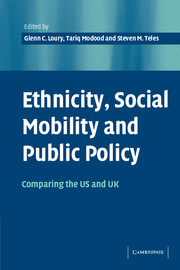Book contents
- Frontmatter
- Contents
- List of figures
- List of tables
- List of contributors
- Acknowledgements
- Introduction
- Part I Historical overviews
- Part II Informal social networks
- Part III Formal structures
- 9 Educational progress for African-Americans and Latinos in the United States from the 1950s to the 1990s: the interaction of ancestry and class
- 10 The educational attainments of ethnic minorities in Britain
- 11 Why America's black–white school achievement gap persists
- 12 Networks and niches: the continuing significance of ethnic connections
- 13 Nonwhite origins, Anglo destinations: immigrants in the USA and Britain
- 14 Social mobility of ethnic minorities
- 15 Ethnic minorities, employment, self-employment, and social mobility in postwar Britain
- Part IV Political institutions and processes
- Part V Normative analysis
- Author index
- Subject index
- References
12 - Networks and niches: the continuing significance of ethnic connections
Published online by Cambridge University Press: 22 September 2009
- Frontmatter
- Contents
- List of figures
- List of tables
- List of contributors
- Acknowledgements
- Introduction
- Part I Historical overviews
- Part II Informal social networks
- Part III Formal structures
- 9 Educational progress for African-Americans and Latinos in the United States from the 1950s to the 1990s: the interaction of ancestry and class
- 10 The educational attainments of ethnic minorities in Britain
- 11 Why America's black–white school achievement gap persists
- 12 Networks and niches: the continuing significance of ethnic connections
- 13 Nonwhite origins, Anglo destinations: immigrants in the USA and Britain
- 14 Social mobility of ethnic minorities
- 15 Ethnic minorities, employment, self-employment, and social mobility in postwar Britain
- Part IV Political institutions and processes
- Part V Normative analysis
- Author index
- Subject index
- References
Summary
At the top of the immigration research agenda stands the question of how the newcomers change after they have arrived. The conventional wisdom, both academic and popular, says that immigrants should change by entering the American mainstream. The concept of assimilation stands as a shorthand for this point of view.
In its canonical form, the theory of assimilation began with the assumption that immigrants would arrive as “ethnics,” an identity reinforced by their tendency to recreate their own social worlds. Cultural change would come first, as Americanization made the second generation quite different from their forebears in tastes, everyday habits, and preferences. But Americanization could proceed even as the ethnic social structure of interpersonal relations largely stood still: as long as immigrants and their descendants remained embedded in ethnic neighborhoods, networks, and niches, integration into the fabric of American society would have to wait. Once ethnic boundaries were crossed, however, increasing exposure probabilities to outsiders would inevitably pull ethnic communities apart: with the move from ethnic ghetto to suburb, interethnic friendships, networks, and eventually marriages would all follow in due course. Thus, the advent of structural assimilation, to borrow the influential term coined by Milton Gordon, signaled entry into the “mainstream,” and the beginning of the end for any distinctiveness associated with the immigrant generation (Gordon 1964).
All this is now entirely familiar to the students of American ethnicity.
- Type
- Chapter
- Information
- Ethnicity, Social Mobility, and Public PolicyComparing the USA and UK, pp. 342 - 362Publisher: Cambridge University PressPrint publication year: 2005
References
- 27
- Cited by



